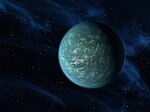astro.wikisort.org - Nebula
Kronberger 61, also known as the "soccer ball", is a planetary nebula discovered by an amateur astronomer in January, 2011, with the newer images having been taken by the Gemini Observatory.[2] The nebula is named for Austrian Mattias Kronberger, who is a member of the amateur group Deep Sky Hunters. The object is estimated to lie 13,000 light-years away. They discovered the nebula while searching near the northern constellation of Cygnus.[3] It is hoped that the discovery will help resolve a decades-old debate, regarding the role of stellar companions in the formation and structure of planetary nebulae.[4]
| Emission nebula | |
|---|---|
| Planetary nebula | |
 Image of the Kronberger 61 nebula taken by the Gemini Observatory | |
| Observation data: J2000 epoch | |
| Right ascension | 19h 21m 38.936s[1] |
| Declination | +38° 18′ 57.2420″[1] |
| Apparent dimensions (V) | 1' 30" |
| Constellation | Cygnus |
| Designations | Kronberger 61, Soccer Ball Nebula[1] |
The nebula is within a relatively small area, which is currently being monitored by NASA's Kepler planet finding mission and the light of the nebula is primarily due to the emissions from doubly ionized oxygen.[4]
See also
- IRAS 19475+3119, protoplanetary nebula of Cygnus
- List of largest nebulae
References
- "NAME Soccer Ball Nebula". SIMBAD. Centre de données astronomiques de Strasbourg. Retrieved 30 August 2015.
- Mosher, Dave. "'Soccer Ball' Nebula Discovered by Amateur Astronomer". National Geographic.
- Moore, Kurt (July 28, 2011). "New Planetary Nebula Found By Amateur Astronomer". KRIV (TV). Archived from the original on April 5, 2012.
- Jacoby, George. "Gemini Observatory Image Release". Gemini Observatory.
На других языках
[de] Kronberger 61
Kronberger 61 oder kurz Kn 61 ist ein Planetarischer Nebel im Sternbild Leier. Der Nebel ist von dem Physiker und Amateurastronom Matthias Kronberger in den Daten der Digitized Sky Survey entdeckt worden.[1]- [en] Kronberger 61
[ru] Кронбергер 61
Кронбергер 61 (англ. Kronberger 61, Kn 61) — планетарная туманность, открытая астрономом-любителем в январе 2011 года при исследовании изображений, полученных в обсерватории Джемини; также имеет название туманность Футбольный мяч (англ. Soccer ball).[3] Туманность названа в честь австрийца Маттиаса Кронбергера (англ. Mattias Kronberger), являющегося участником группы Deep Sky Hunters. Объект находится на расстоянии 13 тысяч световых лет от Солнца и был обнаружен при исследовании северного созвездия Лебедя.[4] Есть вероятность, что открытие данного объекта поможет разрешить вопрос о роли компаньонов звёзд в формировании и структуре планетарных туманностей.[5]Другой контент может иметь иную лицензию. Перед использованием материалов сайта WikiSort.org внимательно изучите правила лицензирования конкретных элементов наполнения сайта.
WikiSort.org - проект по пересортировке и дополнению контента Википедии


